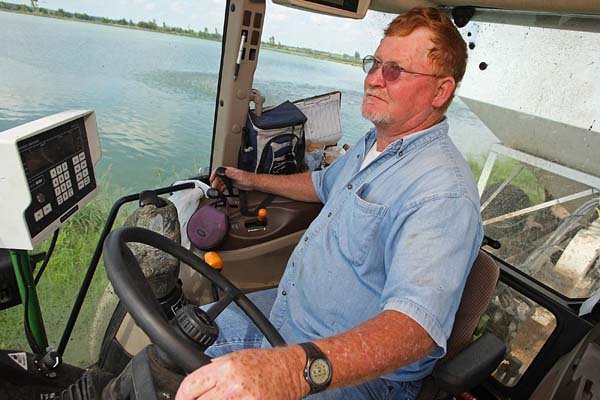LITTLE ROCK — The catfish industry in Arkansas is continuing its downward spiral, with fish inventories and acreage at their lowest levels in more than 10 years, according to a U.S. Department of Agriculture report.
Food-size catfish inventory fell 32 percent, to 27.7 million fish, down from almost 41 million last year. Watersurface acreage has been cut in half in the past three years,to under 15,000 acres that will be used from July 1 through Dec. 31.
Catfish producers have been battered in recent years by high feed prices and competition from foreign imports. This is the third consecutive year of decline for both inventory and acreage.
Many catfish farmers have left the business entirely or have begun the process of turning to row crops.
Alice-Sidney Farms LP in Chicot County near Jeromeis in the process of converting all its ponds to rice fields, said Bill Troutt, the farm’s manager. The 7,000-acre farm once operated 1,400 acres of fish ponds and is now down to 600. Barring a sharp drop in grain prices or foreign imports, Troutt expects to be out of the catfish business altogether in two years.
“Imports have just killed us to the point that it’s not profitable,” Troutt said. “We’ve been losing money every year for four years now.”
More than 129 million pounds of filleted, fresh, chilled or frozen catfish was imported to the U.S. in 2009, up from 8 million a decade ago, according to U.S. Department of Agriculture figures. Last year, 476 million pounds of domestically produced catfish were sold.
Joey Lowery has taken about 25 percent of his 450 acres of ponds in Newport out of production. He said the competition from Chi-nese and Vietnamese fish has put an “unofficial ceiling” on prices.
Lowery, who is president of Catfish Farmers of America, is campaigning to have imported-catfish inspections moved from the Food and Drug Administration to the U.S. Department ofAgriculture, arguing that the move would put imported and domestic fish on a level playing field.
Catfish farmers are eligible for up to $12,000 in assistance through a federal Trade Adjustment Assistance program intended to help them compete more effectively or switch to other crops.
More-expensive feed, fueled by rising corn and grain prices, have also cut into catfish farmers’ profits. Feed prices rose last year to more than $400 a ton, the highest ever seen in the industry, said Carole Engle, director of the Aquaculture/Fisheries Center at the University of Arkansas at Pine Bluff.
“There is not a way that I could find for catfish farming to be profitable [at that feed price],” she said.
Wayne Branton, who owns Mainline Fisheries in Ashley County, said his feed costs rose from $850,000 in 2007 to $1.3 million the next year.
“It makes a tremendous difference in bottom line,” he said. Branton has cut his production to 800 acres, from a high of 1,200.
Though feed prices have since dropped below $300 aton, which Engle said allows producers to make money, last year’s high prices prompted many farmers to begin taking ponds out of production. Since farmers must wait up to 18 months for their fish to reach a marketable size before selling their product, the decisions made last year are just now being reflected in acreage numbers.
Arkansas lost substantially more acreage than Mississippi or Alabama, the two states that rank ahead of it in terms of acreage used for catfish production. Mississippi lost 10,000 acres and has 60,000 remaining in production forthe second half of the year. Alabama lost less than 2,000 acres and has 20,600 remaining in production.
“People in Alabama raising catfish don’t have as many other options. ... They don’t have the option to go into row crops,” Engle said. “Farmers in the Delta have quite-profitable options.”
A shortage of in-state processing capacity has also put Arkansas producers at a disadvantage. Branton, who owns a small processing operation that supplies large fish to the Asian market, said that in the past, it had been hard for Arkansas farmers to get into some Mississippi plants in which they don’t have ownership stakes.
Arkansas Catfish Growers, which did business under the name SEACAT, operated catfish-processing plants in Lake Village and Eudora. SEACAT was forced into bankruptcy in June 2004.
“I think that’s kind of started the exodus from the catfish industry probably a year before it started in Mississippi and Alabama,” said Ted Mc-Nulty, director of the Arkansas Agriculture Department’s Aquaculture Division.
Business, Pages 27 on 07/28/2010
